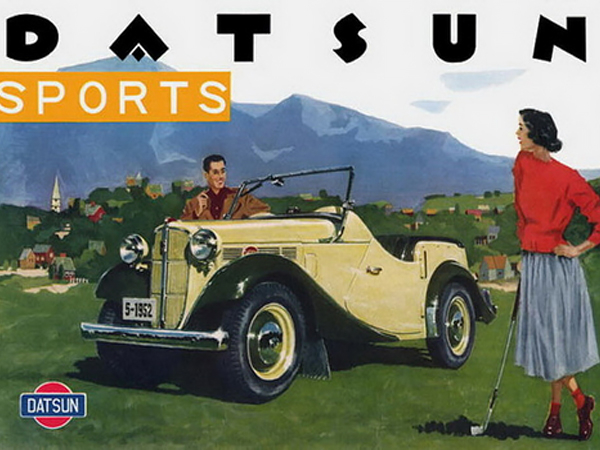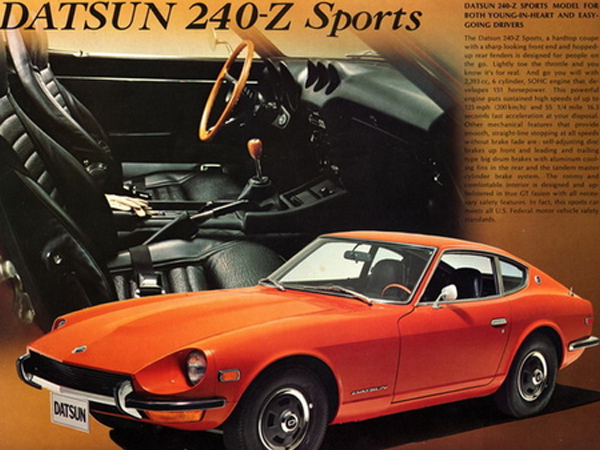Datsun Fairlady history
How it all started with Datsun Sports/Fairlady

DC-3
The first Datsun Sports roadster in 1952 was the DC-3, 50 of them were built.

S211
In 1959, the S211 comes on the market, from the same designer as the DC-3. The body is made of glass fiber and has seats for four people. Only 20 of them have been built.
To quickly distinguish this model from the SPL212 and SPL213; the front corner of the door is rounded 90 degrees instead of sharply cut off.

SPL212
In 1960 comes the SPL212, this is only built for export. The steering wheel is on the left and is indicated in the type with the letter L. The body remains room for four people but the body is now made of steel instead of glass fiber. This is the first roadster with Fairlady emblems.
This model was used at various races in the USA. 288 units were sold, all to the US.

SPL213
The sale started in 1961 and remained on sale until the beginning of 1963. The model is the same as the SPL212 and can only be distinguished by the color of the rims (gray).
There are adjustments made to the brakes (other rims) and to the engine. Also this model was only sold with a steering wheel at the left to the USA market, this time 217 pieces.

SP(L)310 Fairlady 1500
Because an MG-B can be found on every street corner, a similarity is quickly made, it has even been called a Sunbeam. But for those who look better, see that this Japanese has more similarities with the Fiat 1200 Spider. Despite the fact that Datsun Austin copied their technique under license, the Fairlady was first shown in 1961, well before the introduction of the MG-B. In fact, because it was a huge process at the time to make a new model production-ready, it was impossible to copy a car in the same time. This also applies to the other way around ".
Except that both cabriolets are small, they do not have much in common. The Datsun has, for example, a chassis with a body, while the MG-B has a self-supporting body. The 1500 (which stands for the number of cc's) was produced from October '62 until August '64. This model is known for its 3rd seat, right behind the right seat and placed slightly higher. This transverse seat disappeared from the car at the end of '64. Other recognizable parts are the grill and dashboard that has been painted in the same color as the body. The 1500 has a "G" engine and there were parts used from the Bluebird 310. The battery is placed under the 3rd seat and has the plus to mass, so pay attention with the electrical system and boosting your battery!
In 1965, the 1500 has become a real 2-person roadster, where first the transversely placed chair was, is now constructed a shelf, this moved the battery to the engine room and the electrical system is now a (normal) minus mass. The dashboard is one of the '66 1600, with more gauges and a different set up.

SP(L)311 Datsun Sports 1600
From 1965 to early 1967, the 1600 will be on the market. It has an "R" engine, a recognizable grill with 3 horizontal bars, a windshield with a vertical bar and a gray dashboard with 7 chrome instruments and 4 toggle switches.

SP(L)311 Datsun Sports 1600 & SR(L)311 Datsun Sports 2000 1967 ½
The so-called 1967 half model. Both in 1600 and 2000 model. This is the model with reduced chrome in the interior. This model has specific characteristics and was only made half a year, because in 1968 a completely renovated interior was fitted due to safety requirements in the USA. The chrome parts are made gray on the inside, against the dazzling by the sun.
The dashboard is black with 5 instruments whose edges are now black (instead of chrome) and now has 3 toggle switches. The door openers on the inside have become a egg-shaped pull mechanism. The appearance is almost the same as the previous models.
The 2000 engine in this "low windshield" model is now a days one of the most wanted roadster models, only a few are delivered to Europe, these have a KMH speedo instead of MPH.

SP(L)311 Datsun Sports 1600 en SR(L)311 Datsun Sports 2000
In 1968 there are major changes due to safety requirements in the USA. On the outside, this is quickly recognizable by the windshield, this is now part of the body rather than a loose screwed frame. This windshield is also increased (more than 6cm), insiders speak about "high" and "low windshield" models. This "high windshield" has no expandable triangle window at the side. Other notable changes are the door handles. These are now integrated into the door and hinge instead of the screwed-on door handles with push button to unlock. The most radical change is the interior. The dashboard is now completely made of foam with deepened instruments. Even the steering wheel has a thick "padded" horn. The radio is placed vertically in the center console. The door openers on the inside have a pull mechanism and are rectangular.
The 1600's were still equipped with the "R"-engine. The 2000s have a "U"-engine with overhead camshaft and five gearbox, good for 135 SAE PK. On the outside they can be quickly identified by the grill where the 3 horizontal bars are closer together with a D in the middle is 2000 the 1600 still has the 3 bars in the grill. Also the badges/emblems on the fenders and at the rear will indicate "1600" or "2000".
The 1968 models have no side marker and the license plate light is still mounted on the rear bumper. Due to the safety requirements from 1968 you could opt for headrests, from '69 they are standard delivered wih the car.
The 1969 models have a drop shaped side marker on the front fender and a round one at the rear. The license plate light now comes with two lights on both sides next to the license plate on the body. (Note Japanese models always have teardrop-shaped flashing lights on the front wings, no matter which year).
The 1970 models have rectangular side markings all around, no more chrome ring around the city lights / indicators at the front and the reflectors at the rear are now bigger and no longer mounted above the tail lights but next to it.

S30 Datsun 240Z, 260Z, 280Z '74-'77
From 1970 the 240Z took over the roadster, in Japan still called Fairlady (FairladyZ). A beautifully lined coupe with a 6 cylinder inline engine with a capacity of 2400cc. In 1974 comes the 260Z which also became available as 2+2. The coupe looks almost exactly the same as the 240Z. The small characteristic differences are in a slightly different middle section in the dashboard, the reverse row lights are placed next to the rear light units instead of integrated and the interior gets carpet instead of checkered vinyl and the self-supporting body has reinforced beams. In the USA the 260Z is only sold for one year and for 4 years in the Netherlands, because of more strict environment rules in the USA they had to go to a self injection fuel system for better performance.
The 260Z was immediately followed by the 280Z in the USA after that one year, while the 280Z was never sold in the Netherlands. The 280Z, from 1975 in the USA, has a 2800cc fuel injection engine and was also available as 2+2. This model can quickly be recognized by two air vents in the bonnet.

S130 Datsun 280ZX '78-'83
In 1978 comes the 280ZX. A completely renewed "sports car" which succeeded the Z-series. Only the sugar scoops, which have been mounted since the Fairlady Roadster, have been retained. The 280ZX is more of a Gran Tourismo car, based on luxury and comfort with a 2800cc line 6 injection engine. The 280ZX was available in different versions, in coupe, 2+2, with T-bar (two removable glass roof panels), with turbo, with digital or analogue dashboard and the most extravagant interior colors.
Several editions have been released, best known is the 10th Anniversary in Black Gold edition, but there was also a Black Red 10th Anniversary edition.
In 1982 came a facelift model. The bumpers are now in color of the car body instead of rubber with chrome. The rear lights look more slick with horizontal "bars" and there are more modern vents in the hood.

Z31 Nissan 300ZX '84-'89
In 1984, the 280ZX is succeeded by the 300ZX, again a completely new developed "sports car" in various versions such as the 280ZX mentioned above. (Do not confuse this model with the more familiar 300ZX Twin Turbo, the Z32, which came on the market from 1990 onwards). The Nissan 300ZX is just like the 280ZX based on luxury and comfort. The Datsun emblems make way for Nissan. The 300ZX has a 3000cc V6 engine. This model also came as a 50th Anniversary version in a two-tone color.
In the USA in 1986 came a facelift model. It has rounder shapes with more flared wheel arches and long, narrow tail lights. And in 1987 this model was facelifted again up to 1989. In Europe the 1986 (in between) model was never delivered.
In 1990 the (Z32) 300ZX Twin Turbo took over and later the 350Z (Z33) and 370Z.
For more information about all Fairlady models, register of owners in the Netherlands and Europe, visit Erica's website www.datsunfairlady.nl.

